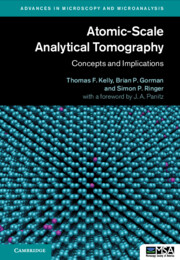Book contents
- Atomic-Scale Analytical Tomography
- Advances in Microscopy and Microanalysis
- Atomic-Scale Analytical Tomography
- Copyright page
- Dedication
- Contents
- Foreword
- Atomic-Scale Analytical Tomography (ASAT)
- Preface
- Acknowledgments
- Introductory Section
- 1 The Need for ASAT
- 2 History of Atomic-Scale Microscopy
- 3 Development of ASAT as a Concept
- Core Section
- Implications Section
- Index
- References
3 - Development of ASAT as a Concept
from Introductory Section
Published online by Cambridge University Press: 03 March 2022
- Atomic-Scale Analytical Tomography
- Advances in Microscopy and Microanalysis
- Atomic-Scale Analytical Tomography
- Copyright page
- Dedication
- Contents
- Foreword
- Atomic-Scale Analytical Tomography (ASAT)
- Preface
- Acknowledgments
- Introductory Section
- 1 The Need for ASAT
- 2 History of Atomic-Scale Microscopy
- 3 Development of ASAT as a Concept
- Core Section
- Implications Section
- Index
- References
Summary
This chapter begins with a formal definition of Atomic-Scale Analytical Tomography (ASAT) and the origins of the concept. The progression of experimental atomic-scale microscopies that led to ASAT concepts is reviewed, and the people and projects are highlighted. Once ASAT is established as a concept, its implications for structure-properties microscopy, coupled through Integrated Computational Materials Engineering (ICME), become obvious. A forward-looking roadmap for ASAT considers what length scales and atom counts in ASAT images are needed to address important microstructural questions. The chapter concludes with the notion that microscopy is at an inflection point: having reached the ultimate building blocks, the drive to see smaller and smaller must now evolve to a drive to see more and more of a structure.
- Type
- Chapter
- Information
- Atomic-Scale Analytical TomographyConcepts and Implications, pp. 40 - 52Publisher: Cambridge University PressPrint publication year: 2022



